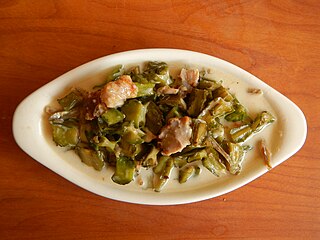
Chow mein is a Chinese dish made from stir-fried noodles with vegetables and sometimes meat or tofu. Over the centuries, variations of chǎomiàn were developed in many regions of China; there are several methods of frying the noodles and a range of toppings can be used. It was introduced in other countries by Chinese immigrants. The dish is popular throughout the Chinese diaspora and appears on the menus of most Chinese restaurants abroad. It is particularly popular in India, Nepal, the UK, and the US.

Pad thai, phat thai, or phad thai, is a stir-fried rice noodle dish commonly served as a street food in Thailand as part of the country's cuisine. It is typically made with rice noodles, shrimp, peanuts, a scrambled egg, and bean sprouts. The ingredients are fried in a wok.

Filipino cuisine is composed of the cuisines of more than a hundred distinct ethnolinguistic groups found throughout the Philippine archipelago. A majority of mainstream Filipino dishes that compose Filipino cuisine are from the food traditions of various ethnolinguistic groups and tribes of the archipelago, including the Ilocano, Pangasinan, Kapampangan, Tagalog, Bicolano, Visayan, Chavacano and Maranao ethnolinguistic groups. The dishes associated with these groups evolved over the centuries from a largely indigenous base shared with maritime Southeast Asia with varied influences from Chinese, Spanish and American cuisines, in line with the major waves of influence that had enriched the cultures of the archipelago and adapted using indigenous ingredients to meet local preferences.

Naga, officially the City of Naga or the Pilgrim City of Naga, is a 1st class independent component city in the Bicol Region of the Philippines. According to the 2020 census, it has a population of 209,170 people.

Pancit, also spelled pansít, is a general term referring to various traditional noodle dishes in Filipino cuisine. There are numerous types of pancit, often named based on the noodles used, method of cooking, place of origin, equal and constant diameter or the ingredients. Most pancit dishes are characteristically served with calamansi, as its freshly-squeezed juice may be used for additional seasoning.

Noodle soup refers to a variety of soups with noodles and other ingredients served in a light broth. Noodle soup is a common dish across East Asia, Southeast Asia and the Himalayan states of South Asia. Various types of noodles are used, such as rice noodles, wheat noodles and egg noodles.
Mark of Lisbon, properly Marcos da Silva, was a Portuguese Franciscan, historian, and the Bishop of Porto.

Batchoy, alternatively spelled batsoy, is a Filipino noodle soup of pork offal, crushed pork cracklings, chicken stock, beef loin, and round noodles. The original and most popular variant, the La Paz batchoy, traces its roots to the Iloilo City district of La Paz, in the Philippines.

Kinilaw is a raw seafood dish and preparation method native to the Philippines. It is also referred to as Philippine ceviche due to its similarity to the Latin American dish ceviche. It is more accurately a cooking process that relies on vinegar and acidic fruit juices to denature the ingredients, rather than a dish, as it can also be used to prepare meat and vegetables. Kinilaw dishes are usually eaten as appetizers before a meal, or as finger food with alcoholic drinks. Kinilaw is also sometimes called kilawin, but it should not be confused with the northern Philippine grilled meat dish, kilawin, to which it is related to but is different.

Laing, is a Filipino dish of shredded or whole taro leaves with meat or seafood cooked in thick coconut milk spiced with labuyo chili, lemongrass, garlic, shallots, ginger, and shrimp paste. It originates from the Bicol Region, where it is known simply as pinangat. Laing is also a type of ginataan, and thus may also be referred to as ginataang laing. Laing is commonly eaten as a vegetable side to complement meat or fish side dishes known as ulam in Filipino, which is normally paired with boiled white rice.

Philippine adobo is a popular Filipino dish and cooking process in Philippine cuisine that involves meat, seafood, or vegetables marinated in vinegar, soy sauce, garlic, bay leaves, and black peppercorns, which is browned in oil, and simmered in the marinade. It has occasionally been considered the unofficial national dish in the Philippines.

Puchero is a type of stew originally from Spain, prepared in Yucatán, Mexico, Argentina, Paraguay, Uruguay, Perú, south of Brazil, the Philippines, and Spain, specifically the autonomous communities of Andalusia and the Canary Islands. The Spanish word "puchero" originally meant an earthenware pot, before being extended to mean any vessel, and then the dish cooked in it.

Milmyeon is a noodle dish that originated in Busan, South Korea. Milmyeon is a variant of the North Korean noodle dish naengmyeon. It consists of wheat noodles in a cold meat broth or a spicy sauce, and topped with vegetables and garnish.

Carapulcra, or carapulca, is an ancient Andean dish that has been prepared for centuries by both Quechua peoples and Aymara peoples. The original term for this dish in the Aymara language is qala phurk'a, which means a stew made with hot stones. In contemporary Peruvian cuisine and Bolivian cuisine, it is a stew of pork and papa seca, with peanuts, aji panca and mirasol peppers, garlic, and other spices like clove. In ancient times llama meat or alpaca meat would have been used, and some people still use these meats today. It is usually eaten with rice, boiled potatoes or yuca.

Pancit Molo or Filipino pork dumpling soup is a type of soup using wonton wrappers which originated from Molo district in Iloilo City, Philippines. It consists of a mixture of ground pork wrapped in molo or wonton wrapper, shredded chicken meat, and also shrimp. The piping-hot soup is often ladled into serving bowls, and garnished with green onions and fried garlic bits for another layer of flavor. Pancit, which loosely translates to "noodle" is a common cuisine in the Philippines. The "noodle" acting in this dish comes from the wonton wrappers added to this dish, which draws from Chinese cuisine. Under this influence, the wontons within the soup have been compared to "siomai dumplings."

The Vocabulario de la lengua bicol is a list of vocabulary of the Bicol language, collected by Marcos de Lisboa when he was assigned to Bicol Region, Philippines.

Gising-gising, also known as ginataang sigarilyas, is a spicy Filipino vegetable soup or stew originating from the provinces of Nueva Ecija and Pampanga in the Philippines. It is traditionally made with chopped winged beans, and coconut milk spiced with labuyo chili, garlic, onions, and bagoong alamang. The name literally means "wake up, wake up". It can be eaten alone, on top of rice, or as a side dish to grilled meat dishes. It is a type of ginataan.
Pancit buko, is a Filipino dish made from very thin strips of young coconut (buko) meat with various spices, vegetables, and meat or seafood. It is a type of Filipino noodle dish (pancit), even though it does not usually use actual noodles.

Basahan script, also known as Guhit, is the native name used by Bicolanos to refer to Baybayin.


















